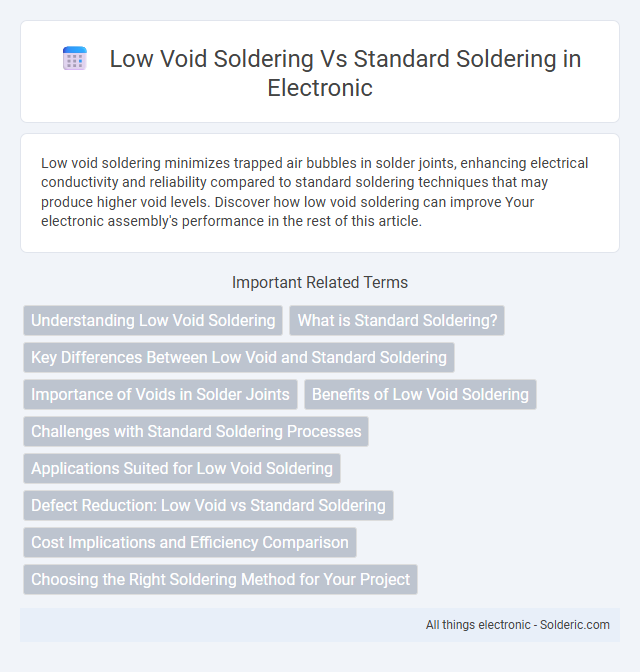Low void soldering minimizes trapped air bubbles in solder joints, enhancing electrical conductivity and reliability compared to standard soldering techniques that may produce higher void levels. Discover how low void soldering can improve Your electronic assembly's performance in the rest of this article.
Comparison Table
| Feature | Low Void Soldering | Standard Soldering |
|---|---|---|
| Void Percentage | Less than 5% | 10-30% |
| Reliability | High - reduces solder joint failures | Moderate - higher risk of void-related issues |
| Thermal Conductivity | Improved - better heat dissipation | Standard levels |
| Process Complexity | Higher - requires controlled atmosphere and temperature profiles | Lower - conventional soldering methods |
| Cost | Higher initial investment | Lower cost |
| Applications | High-reliability electronics, aerospace, automotive | General electronics manufacturing |
| Use of Flux | Optimized flux formulations to reduce voids | Standard flux |
Understanding Low Void Soldering
Low void soldering minimizes the formation of gas pockets beneath solder joints, enhancing electrical conductivity and thermal performance compared to standard soldering techniques. This process uses specialized fluxes and optimized reflow profiles to reduce void content, which improves reliability in high-density electronic assemblies. Understanding low void soldering helps you achieve stronger bonds and longer-lasting circuit board performance.
What is Standard Soldering?
Standard soldering involves the process of joining electronic components using a solder alloy, typically composed of tin and lead or lead-free alternatives, to create electrical and mechanical bonds. This method can result in voids or air pockets within the solder joint, potentially affecting reliability and performance. You can improve joint quality by comparing this traditional approach with low void soldering techniques designed to minimize these defects.
Key Differences Between Low Void and Standard Soldering
Low void soldering significantly reduces the presence of microscopic gas bubbles within solder joints, enhancing thermal and electrical conductivity compared to standard soldering. It employs specialized fluxes and controlled reflow profiles to minimize void formation, resulting in improved joint reliability and mechanical strength. Standard soldering typically exhibits higher void content, which can lead to decreased performance and increased risk of joint failure in high-reliability electronic assemblies.
Importance of Voids in Solder Joints
Voids in solder joints significantly impact thermal and electrical conductivity, potentially causing reliability issues and failure in electronic assemblies. Low void soldering techniques minimize trapped gases and intermetallics, enhancing joint integrity and performance under mechanical stress. Your choice of soldering method directly influences the durability and functionality of critical components in high-reliability applications.
Benefits of Low Void Soldering
Low void soldering significantly reduces the formation of voids within solder joints, enhancing thermal and electrical conductivity compared to standard soldering methods. This improvement minimizes potential failures and extends the reliability and lifespan of your electronic assemblies, especially in high-performance applications. Enhanced heat dissipation and mechanical strength make low void soldering a preferred choice for critical components in advanced electronics manufacturing.
Challenges with Standard Soldering Processes
Standard soldering processes often face challenges such as high void formation, which can compromise joint reliability and thermal conductivity in electronic assemblies. Excessive voids lead to weak mechanical connections and increased risk of component failure under thermal or mechanical stress. You can improve performance and reduce defects by opting for low void soldering techniques that optimize solder paste formulations and reflow profiles.
Applications Suited for Low Void Soldering
Low void soldering excels in applications requiring high reliability and thermal management, such as aerospace electronics, medical devices, and advanced semiconductor packaging. This technique minimizes trapped gases and voids, enhancing thermal conductivity and mechanical strength in power modules and LED assemblies. Standard soldering, while adequate for general electronics, may not meet the stringent performance criteria of high-power and high-frequency devices where low void soldering is preferred.
Defect Reduction: Low Void vs Standard Soldering
Low void soldering significantly reduces solder joint voids compared to standard soldering, improving thermal and electrical conductivity essential for high-reliability electronics. You benefit from enhanced mechanical stability and lower risk of failures caused by void-related weaknesses in solder joints. This reduction in defects leads to longer product lifespans and higher yield in manufacturing processes.
Cost Implications and Efficiency Comparison
Low void soldering reduces defects and rework costs by minimizing solder voids, which enhances thermal and electrical reliability in electronic assemblies. Standard soldering may have lower initial material expenses but often incurs higher long-term costs due to increased failure rates and warranty claims. Your production efficiency improves with low void soldering through decreased inspection time and improved yield rates, making it a cost-effective choice for high-reliability applications.
Choosing the Right Soldering Method for Your Project
Low void soldering significantly reduces the number and size of voids in solder joints, ensuring enhanced electrical performance and mechanical reliability compared to standard soldering. This method is ideal for high-frequency or heat-sensitive electronic components where voids can cause failures or reduced conductivity. By choosing low void soldering for your project, you minimize thermal resistance and improve overall product lifespan.
Low void soldering vs standard soldering Infographic

 solderic.com
solderic.com